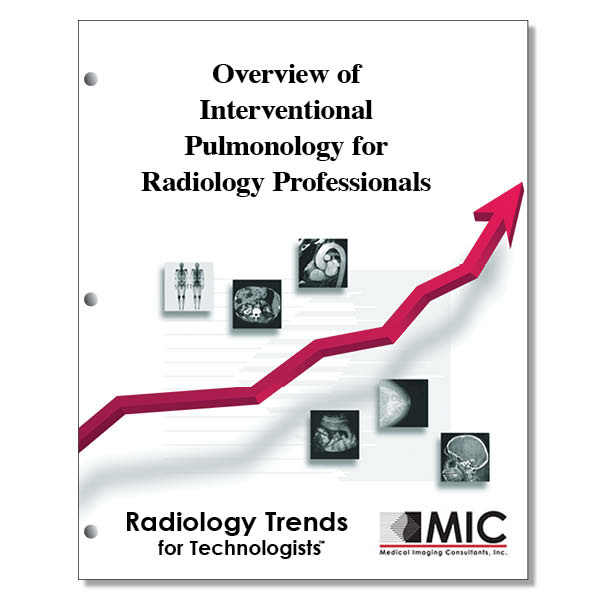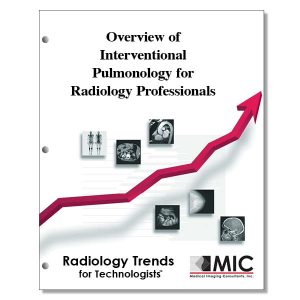

Overview of Interventional Pulmonology for Radiology Professionals
With interventional pulmonology quickly evolving as a subspecialty of pulmonary medicine, this course shows how imaging plays a key role in detailing the relevant anatomy and measurements for procedure planning, and monitoring patients for successful outcomes and complications.
Course ID: Q00706 Category: Radiology Trends for Technologists Modalities: CT, Nuclear Medicine, Radiation Therapy, Radiography, Sonography, Vascular Interventional2.75 |
Satisfaction Guarantee |
$29.00
- Targeted CE
- Outline
- Objectives
Targeted CE per ARRT’s Discipline, Category, and Subcategory classification:
[Note: Discipline-specific Targeted CE credits may be less than the total Category A credits approved for this course.]
Computed Tomography: 1.00
Procedures: 1.00
Neck and Chest: 1.00
Nuclear Medicine Technology: 0.25
Procedures: 0.25
Other Imaging Procedures: 0.25
Radiography: 0.25
Procedures: 0.25
Thorax and Abdomen Procedures: 0.25
Registered Radiologist Assistant: 1.50
Procedures: 1.50
Thoracic Section: 1.50
Radiation Therapy: 0.25
Procedures: 0.25
Treatments: 0.25
Vascular-Interventional Radiography: 1.50
Procedures: 1.50
Nonvascular Procedures: 1.50
Outline
- Introduction
- Training and Certification
- Types of Bronchoscope
- Rigid Bronchoscope
- Flexible Bronchoscope
- Diagnostic Bronchoscopy
- Endobronchial US
- Peripheral Bronchoscopy
- Therapeutic Bronchoscopy
- Mechanical Debulking
- Ablative Procedures
- Electrocautery
- Laser Therapy
- Argon Plasma Coagulation
- Cryotherapy
- Photodynamic Therapy
- Endobronchial Brachytherapy
- Stent Placement
- Balloon Bronchoplasty
- Bronchoscopic Lung Volume Reduction
- Bronchial Thermoplasty
- Fiducial Marker Placement
- Percutaneous Tracheostomy
- Pleural Interventions
- Other Evolving Techniques
- Robotic-Assisted Bronchoscopy
- Bronchoscopic Transparenchymal Nodule Access
- Transbronchial Cryobiopsy
- Ablation of Early-Stage Cancers
- Endobronchial Intratumoral Chemotherapy
- Conclusion
Objectives
Upon completion of this course, students will:
- be familiar with AABIP certification
- be familiar with utilization of rigid bronchoscopy
- be familiar with the development of the flexible bronchoscope
- recognize the main component of the flexible bronchoscope
- be familiar with BLRV
- be familiar with the use of hyperpolarized 129Xe MRI in BT
- be familiar with the application of PET to during talc pleurodesis
- be familiar with radial-probe EBUS
- be familiar with clinical application of convex-probe EBUS
- understand the advantages of an ultra-thin bronchoscope
- identify the matrix used for chest CCT for ENB guidance
- be familiar with ENB for detecting cancer
- be familiar with depicting lesions with cone-beam CT and fluoroscopic tomosynthesis
- recognize the clinical signs of CAO
- identify the flexible bronchoscope on coronal CT images
- identify the tools for mechanical debulking
- be familiar with the major indication of electrocautery
- be familiar with photodynamic therapy as a treatment modality
- be familiar with the risks associated with electrocautery
- identify the most commonly used ablation therapy laser
- be familiar with argon plasma coagulation
- be familiar with cryotherapy
- be familiar with photodynamic therapy
- be familiar with endobronchial brachytherapy
- be familiar with the use of CT features of CAO
- identify the main type of stents identified in this article
- recognize the main complication associated with the use of stents
- be familiar with imaging characteristics of silicone stents
- be familiar with the factors determining success for balloon bronchoplasty
- be familiar with BLVR
- be familiar with more invasive alternatives for BLVR
- identify patients that are not candidates for BLVR
- recognize the measurements for CT analysis for pre-BLVR assessment
- be familiar with quantitative CT imaging on BLVR
- recognize the use of SPECT/CT for assessing lung perfusion
- be familiar with the Chartis System
- be familiar with the most frequent adverse effect of BLVR
- be familiar with bronchial thermoplasty
- know which imaging modality uses hyperpolarized 129Xe in guiding therapy to specific airways
- be familiar with the marker used in SBRT
- be familiar with the diagnostic efficiency of medical thoracoscopy
- be familiar with BTPNA
- be familiar with transbronchial cryobiopsy
